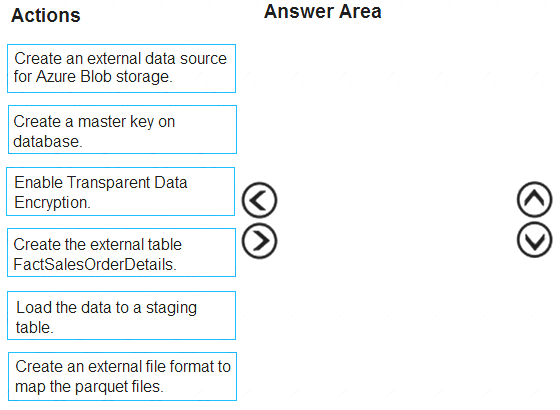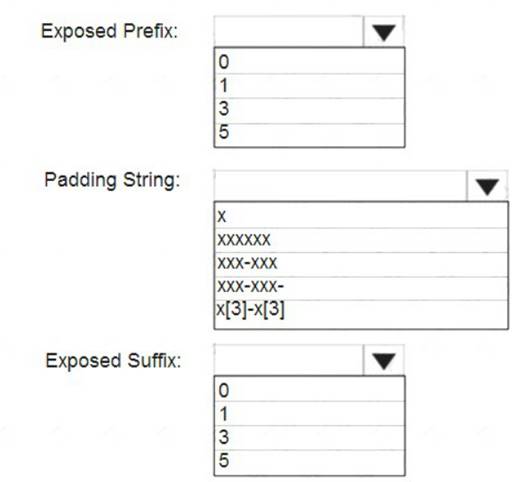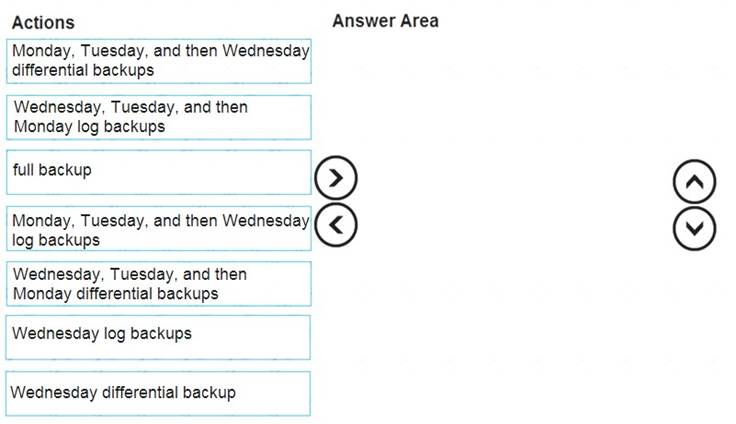- (Exam Topic 5)
You are creating a managed data warehouse solution on Microsoft Azure.
You must use PolyBase to retrieve data from Azure Blob storage that resides in parquet format and load the data into a large table called FactSalesOrderDetails.
You need to configure Azure Synapse Analytics to receive the data.
Which four actions should you perform in sequence? To answer, move the appropriate actions from the list of actions to the answer area and arrange them in the correct order.
Solution:
Graphical user interface, text, application, chat or text message Description automatically generated
To query the data in your Hadoop data source, you must define an external table to use in Transact-SQL queries. The following steps describe how to configure the external table.
Step 1: Create a master key on database.
* 1. Create a master key on the database. The master key is required to encrypt the credential secret. (Create a database scoped credential for Azure blob storage.)
Step 2: Create an external data source for Azure Blob storage.
* 2. Create an external data source with CREATE EXTERNAL DATA SOURCE.. Step 3: Create an external file format to map the parquet files.
* 3. Create an external file format with CREATE EXTERNAL FILE FORMAT. Step 4. Create an external table FactSalesOrderDetails
* 4. Create an external table pointing to data stored in Azure storage with CREATE EXTERNAL TABLE. Reference:
https://docs.microsoft.com/en-us/sql/relational-databases/polybase/polybase-configure-azure-blob-storage
Does this meet the goal?
Correct Answer:
A
- (Exam Topic 5)
You have an Azure SQL database.
Users report that the executions of a stored procedure are slower than usual. You suspect that a regressed query is causing the performance issue.
You need to view the query execution plan to verify whether a regressed query is causing the issue. The solution must minimize effort.
What should you use?
Correct Answer:
C
Use the Query Store Page in SQL Server Management Studio.
Query performance regressions caused by execution plan changes can be non-trivial and time consuming to resolve.
Since the Query Store retains multiple execution plans per query, it can enforce policies to direct the Query Processor to use a specific execution plan for a query. This is referred to as plan forcing. Plan forcing in Query Store is provided by using a mechanism similar to the USE PLAN query hint, but it does not require any change in user applications. Plan forcing can resolve a query performance regression caused by a plan change in a very short period of time.
Reference:
https://docs.microsoft.com/en-us/sql/relational-databases/performance/monitoring-performance-by-using-the-qu
- (Exam Topic 5)
You have an Azure virtual machine named VM1 on a virtual network named VNet1. Outbound traffic from VM1 to the internet is blocked.
You have an Azure SQL database named SqlDb1 on a logical server named SqlSrv1.
You need to implement connectivity between VM1 and SqlDb1 to meet the following requirements:  Ensure that all traffic to the public endpoint of SqlSrv1 is blocked.
Ensure that all traffic to the public endpoint of SqlSrv1 is blocked. Minimize the possibility of VM1 exfiltrating data stored in SqlDb1. What should you create on VNet1?
Minimize the possibility of VM1 exfiltrating data stored in SqlDb1. What should you create on VNet1?
Correct Answer:
C
Azure Private Link enables you to access Azure PaaS Services (for example, Azure Storage and SQL Database) and Azure hosted customer-owned/partner services over a private endpoint in your virtual network.
Traffic between your virtual network and the service travels the Microsoft backbone network. Exposing your service to the public internet is no longer necessary.
Reference:
https://docs.microsoft.com/en-us/azure/private-link/private-link-overview
- (Exam Topic 5)
You have an Azure SQL database that contains a table named Customer. Customer has the columns shown in the following table.
You plan to implement a dynamic data mask for the Customer_Phone column. The mask must meet the following requirements: The first six numerals of each customer’s phone number must be masked.
The first six numerals of each customer’s phone number must be masked.  The last four digits of each customer’s phone number must be visible.
The last four digits of each customer’s phone number must be visible. Hyphens must be preserved and displayed.
Hyphens must be preserved and displayed.
How should you configure the dynamic data mask? To answer, select the appropriate options in the answer area.
Solution:
Box 1: 0
Custom String : Masking method that exposes the first and last letters and adds a custom padding string in the middle. prefix,[padding],suffix
Box 2: xxx-xxx
Box 3: 5 Reference:
https://docs.microsoft.com/en-us/sql/relational-databases/security/dynamic-data-masking
Does this meet the goal?
Correct Answer:
A
- (Exam Topic 5)
You have SQL Server on an Azure virtual machine that contains a database named DB1. DB1 is 30 TB and has a 1-GB daily rate of change.
You back up the database by using a Microsoft SQL Server Agent job that runs Transact-SQL commands. You perform a weekly full backup on Sunday, daily differential backups at 01:00, and transaction log backups every five minutes.
The database fails on Wednesday at 10:00.
Which three backups should you restore in sequence? To answer, move the appropriate backups from the list of backups to the answer area and arrange them in the correct order.
Solution:
Does this meet the goal?
Correct Answer:
A

